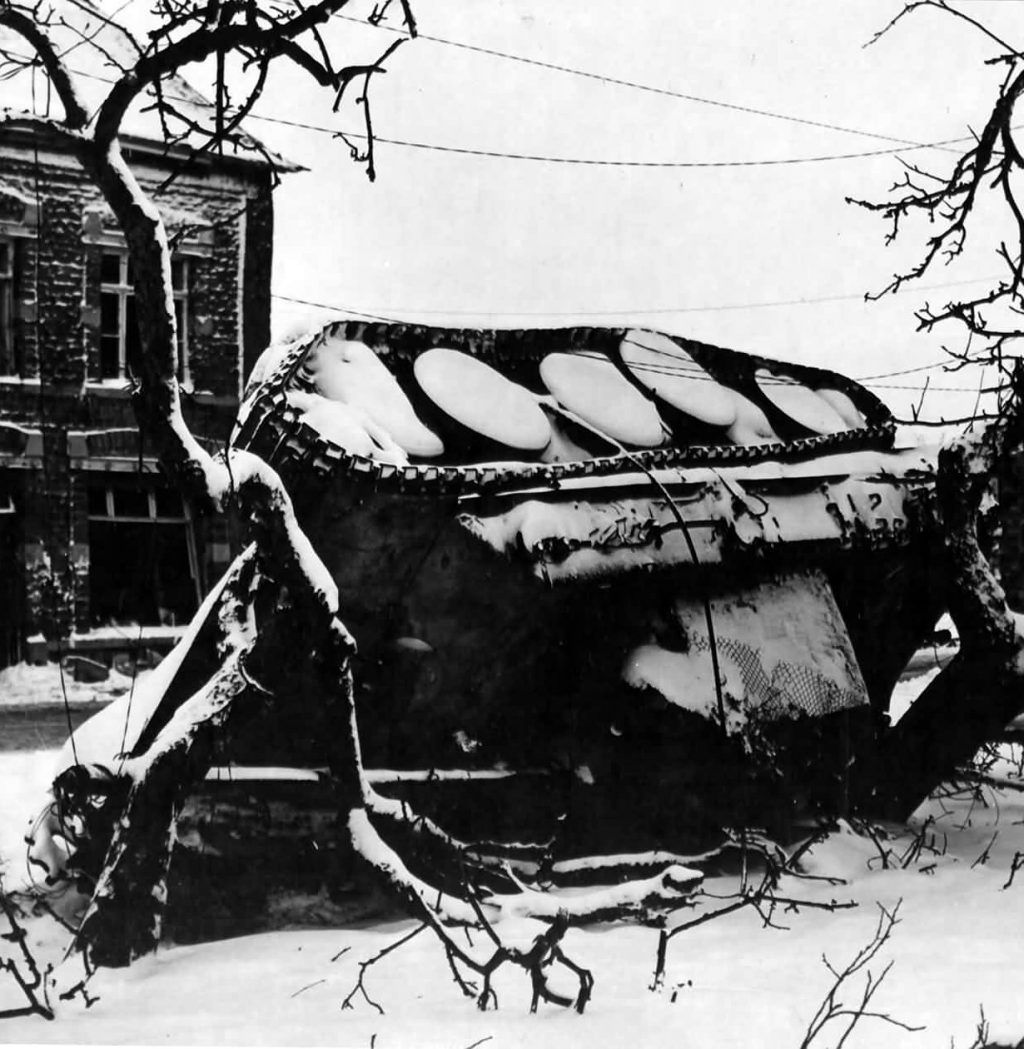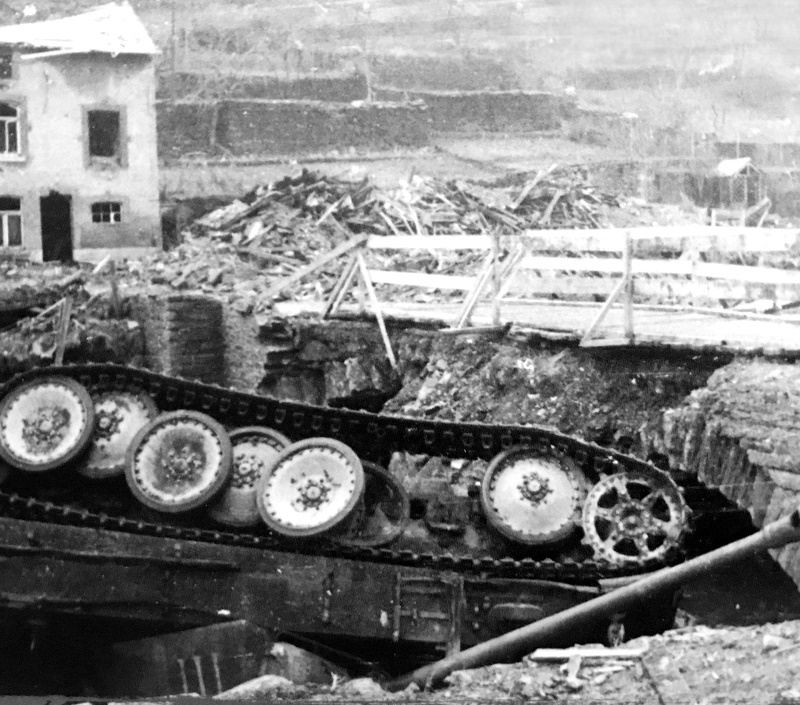A few minutes before 0900, Lt Ellenson reported that his platoon could see troops moving across the high ground directly north on the opposite side of the river. As I turned my attention in that direction, I too could see dismounted men moving southeast across the high ground about 1500 yards away. Being quite certain that these men must be the 1-A troops, I directed that a patrol be sent out to establish contact. The patrol was to proceed with due caution to avoid trouble, should be men we saw prove to be retreating Germans. There was also the probability that our own patrol might be mistaken for an enemy unit. However, it was difficult to restrain the desire of all the men to dash out and establish the initial contact themselves. As the patrol was dispatched, I also directed the tank company to make a determined effort to get into Houffalize. This they were to do by moving due east along the now cleared trail, thence to the high ground south of the objective, and into the town from the south.
The mission of the tank company was not to capture Houffalize single-handed, but rather to conduct one lightning harassing raid to determine so far as possible the German strength in the town. Capt Mullins was told to move into the town, make a rapid tour of that southern portion, and then withdraw to the high ground where Troop D was situated. From his position on the hill south of town, he then could assist Troop D in its overwatching mission and cut off any Germans being forced back by the CCA attack. Fox Co had a little difficulty getting across the open ground, receiving only small arms and mortar fire as it advanced. There was no opposition to its move to the high ground because troops in the town had no good fields of fire. The tanks then moved into the town firing 37-MM and machine guns, setting fire to buildings, flushing several Germans from houses, and then withdrawing to their previously designated positions. I was observing all of this action but at the same time anxiously awaiting word from the contact patrol. From our positions, we could see motor and motor troops trudging through the snow on the far side of the river. Certainly, these must be the long-awaited 1-A elements. Events moved rapidly thereafter. The patrol returned a few minutes before 1000 to report that it had contacted elements of the 41-AIR (2-AD). The juncture between the 1-A and the 3-A had been established, thereby eliminating the Ardennes Salient that the Germans had created in the Allied lines a month before. The mission assigned to the 41-CRS had been accomplished.
I immediately reported this initial contact to squadron headquarters and requested further instructions. In reply, I was notified that the squadron commander was en route to my position and that a platoon of Troop A had contacted patrols from the 334-IR and the 82-AIB (Recon – 2-AD) farther west along the Ourthe River at about the same time that we had contacted the 41-AIR. Seemingly, the two armies were now joining forces all along the river. Upon arrival, Col Foy directed me to maintain my present position until CCA had reached Houffalize. He said that their attack was well underway and that I could expect them to reach the objective within two or three hours. The squadron commander then went with the contact patrol across the river to meet the 41-AIR commander for a comparison of future plans. Upon his return from the personal liaison mission, Col Foy gave me an account of his discussion with the 41-AIR commander, reiterated his instructions as to my actions pending CCA’s arrival, and then returned to the Squadron CP, which was still in Bertogne. For the remainder of the day, our mission was to keep Houffalize and its approaches under observation and to report the progress of CCA.
The combat command was advancing steadily up the road from the southwest, being delayed by a scattered, retreating enemy using roadblocks and mines to great effect. This CCA attack was coordinated with the advance of CCB and the 101-A/B from the south. Shortly after 1300, elements of the 42-TB, CCA, reached their objective, the high ground south of and overlooking Houffalize – the position occupied by the light tanks and Troop D. Through the remaining daylight hours, the balance of CCA closed on the objective; the position was organized for defense, and close contact between units was established all along the line. Control of the Houffalize sector passed to CCA at 1600.
At 1630, the 41-CRS task force withdrew to the Squadron CP at Bonnerue leaving an outpost on the trail west of Houffalize, and patrols along the south bank of the Ourthe River to maintain the contact with 1-A units along the northern bank. The impression made by this single operation on the officers and enlisted men involved was deep and effective. By forced application over a compact twenty-four hour period, all personnel suddenly saw the need for and value of months of pre-combat training. Without Lt Ellenson’s keen ability to read a map under extreme pressure, the column certainly would have been led astray and might never have reached the objective.
Throughout the action, teamwork between men and units; between tanks and dismounted men; and between assault guns and well-located forward observers was acutely apparent to all concerned. Likewise, no one could help but notice the distinct reliance placed on radio communication to achieve maximum coordination with a minimum of effort. In addition, there were many instances demonstrating the soundness of scouting and patrolling techniques; the need for detailed prior planning; effective small-unit leadership; and a variety of other basic elements of Recon unit and individual training. The contact mission as assigned the CG 11-AD was, I believe, an ideal reconnaissance squadron undertaking. The requirements for the success of this type of assignment are a high degree of mobility; maximum surprise; varied, effective firepower; flexible communications; and well organized dismounted men. All of these necessary factors were present within the 41-CRS. The specific mission possibly could have been accomplished by either tank of armored infantry units of the division as effectively, but not without a diversion of the effort of a sacrifice of strength in the main attack. Moreover, the reconnaissance squadron, possessing the tools necessary to accomplish this mission, was readily available to the division commander. The successful accomplishment of this special mission is another example of the capability of a reconnaissance squadron to execute any mission which it may reasonably be assigned. Because of the flexibility and versatility of this type organization, it forms an integral part of the support echelon of the armored division.



















